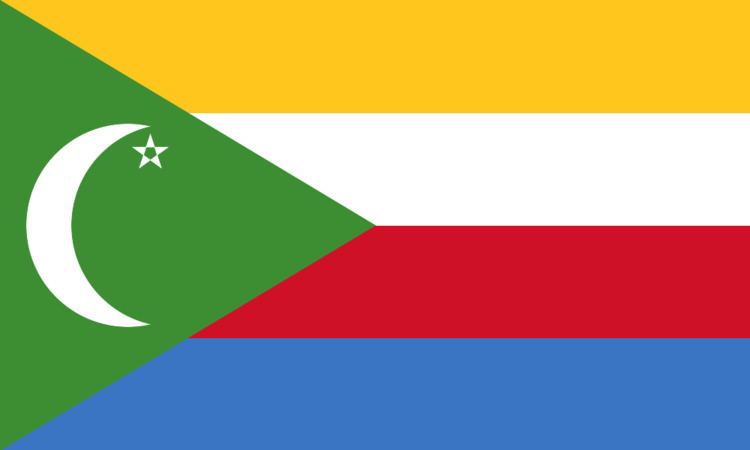Population 734,917 (2013) GNI per capita 1,490 PPP dollars (2013) | Life expectancy 60.64 years (2012) Population growth rate 2.4% annual change (2013) | |
 | ||
Fertility rate 4.78 births per woman (2012) | ||
The Comorians inhabiting Grande Comore, Anjouan, and Mohéli (86% of the population) share African-Arab origins. Islam is the dominant religion, and Quranic schools for children reinforce its influence. Although Islamic culture is firmly established throughout, a small minority are Christian.
Contents
- Map of Comoros
- UN population projections
- Fertility and Births
- CIA World Factbook demographic statistics
- Population
- Age structure
- Median age
- Population growth rate
- Sex ratio
- Life expectancy at birth
- HIVAIDS
- Nationality
- Religions
- Languages
- Literacy
- References
Map of Comoros
The most common language is Comorian, related to Swahili. French and Arabic also are spoken. About 89% of the population is literate.
The Comoros have had seven censuses since World War II:
Population density figures conceal a great disparity between the republic's most crowded island, Nzwani, which had a density of 470 persons per square kilometer in 1991; Ngazidja, which had a density of 250 persons per square kilometer in 1991; and Mwali, where the 1991 population density figure was 120 persons per square kilometer. Overall population density increased to about 285 persons per square kilometer by 1994. By comparison, estimates of the population density per square kilometer of the Indian Ocean's other island microstates ranged from 241 (Seychelles) to 690 (Maldives) in 1993. Given the rugged terrain of Ngazidja and Nzwani, and the dedication of extensive tracts to agriculture on all three islands, population pressures on the Comoros are becoming increasingly critical.
The age structure of the population of the Comoros is similar to that of many developing countries, in that the republic has a very large proportion of young people. In 1989, 46.4 percent of the population was under fifteen years of age, an above-average proportion even for sub-Saharan Africa. The population's rate of growth was a relatively high 3.5 percent per annum in the mid 1980s, up substantially from 2.0 percent in the mid-1970s and 2.1 percent in the mid-1960s.
In 1983 the Abdallah regime borrowed US$2.85 million from the International Development Association to devise a national family planning program. However, Islamic reservations about contraception made forthright advocacy and implementation of birth control programs politically hazardous, and consequently little was done in the way of public policy.
The Comorian population has become increasingly urbanized in recent years. In 1991 the percentage of Comorians residing in cities and towns of more than 5,000 persons was about 30 percent, up from 25 percent in 1985 and 23 percent in 1980. The Comoros' largest cities were the capital, Moroni, with about 30,000 people, and the port city of Mutsamudu, on the island of Nzwani, with about 20,000 people.
Migration among the various islands is important. Natives of Nzwani have settled in significant numbers on less crowded Mwali, causing some social tensions, and many Nzwani also migrate to Maore. In 1977 Maore expelled peasants from Ngazidja and Nzwani who had recently settled in large numbers on the island. Some were allowed to reenter starting in 1981 but solely as migrant labor.
The number of Comorians living abroad has been estimated at between 80,000 and 100,000; during the colonial period, most of them lived in Tanzania, Madagascar, and other parts of Southeast Africa. The number of Comorians residing in Madagascar was drastically reduced after anti-Comorian rioting in December 1976 in Mahajanga, in which at least 1,400 Comorians were killed. As many as 17,000 Comorians left Madagascar to seek refuge in their native land in 1977 alone. About 100,000 Comorians live in France; many of them had gone there for a university education and never returned. Small numbers of Indians, Malagasy, South Africans, and Europeans (mostly French) live on the islands and play an important role in the economy. Most French left after independence in 1975.
UN population projections
Numbers are in thousands. UN medium variant projections.
Fertility and Births
Total Fertility Rate (TFR) (Wanted Fertility Rate) and Crude Birth Rate (CBR):
Structure of the population (DHS 2012) (Males 11 088, Females 12 284 = 23 373) :
Fertility data as of 2012 (DHS Program):
CIA World Factbook demographic statistics
The following demographic statistics are from the CIA World Factbook, unless otherwise indicated.
